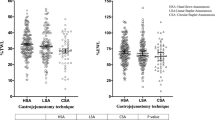Abstract
Background
Weight regain after Roux-en-Y gastric bypass may be caused by pouch enlargement or dilatation of the gastrojejunostomy (stoma). In order to avoid the substantial morbidity of revisional bariatric surgery, investigators have recently demonstrated the feasibility of reducing stoma diameter using transoral endoscopic suturing techniques. Our aim was to demonstrate the feasibility of performing both pouch and stomal reduction using transoral endoscopically placed tissue anchors in an ex vivo and acute animate model.
Methods
Part I: We created an ex vivo model of a dilated gastric pouch and stoma using four explanted porcine stomachs. The stomach was divided to create an upper pouch of approx. 100 ml volume, which was reconnected to the lower portion of the stomach (gastric remnant) via an anastomosis of 18 to 20 mm diameter. Endoscopically placed anchors were then used to create plications of the stoma and reduce its diameter. In two stomachs, anchor plications were also used to decrease pouch volume. Pouch volumes and stoma diameters were measured pre- and post-procedure. Part II: A similar experimental model was created in vivo using three pigs. Anchors were placed in the stoma and pouch. The animals were immediately sacrificed and similar measurements were obtained.
Results
In the ex vivo model, stoma diameter was successfully reduced in all four stomachs by a mean of 8 mm (41%). This represented a mean decrease in cross-sectional area of 65%. Pouch volume was reduced by a mean of 28 ml (30%) in two stomachs. Stomal plications were successfully placed in two of the live animals, with a mean stoma diameter reduction of 11.5 mm (53%). Feasibility of pouch reduction using plicating anchors was confirmed.
Conclusions
This is the first study to demonstrate the feasibility of using endoscopically placed tissue anchors to reduce both stoma diameter and pouch volume. This technique may ultimately be clinically useful in treating weight regain after gastric bypass surgery.






Similar content being viewed by others
References
Santry HP, Gillen DL, Lauderdale DS (2005) Trends in bariatric surgical procedures. JAMA 294:1909–17
Schwartz RW, Strodel WE, Simpson WS, Griffen WO (1988) Gastric bypass revision: lessons learned from 920 cases. Surgery 104:806–12
Christous NV, Look D, MacLean LD (2006) Weight gain after short- and long-limb gastric bypass in patients followed for longer than 10 years. Ann Surg 244:734–40
Deitel M (2001) Avoidance of weight regain after gastric bypass [commentary]. Obesity Surg 11:474
Behrns KE, Smith CD, Kelly KA, Sarr MG (1993) Reoperative bariatric surgery: lessons learned to improve patient selection and results. Ann Surg 218:646–53
Thompson CC, Slattery J, Bundga ME, Lautz DB (2006) Peroral endoscopic reduction of dilated gastrojejunal anastomosis after Roux-en-Y gastric bypass: a possible new option for patients with weight regain. Surg Endosc 20:1744–8
Seaman DL, Gostout CJ, de la Mora Levy JG, Knipschield MA (2006) Tissue anchors for transmural gut-wall apposition. Gastrointest Endosc 64:577–81
Filipi CJ, Lehman GA, Rothstein RI, Raijman I, Stiegmann GV, et al. (2001) Transoral, flexible endoscopic suturing for treatment of GERD: a multicenter trial. Gastrointest Endosc 53:416–22
Mahmood Z, McMahon BP, Arin Q, Byrne PJ, Reynolds JV, et al. (2003) Endocinch therapy for gastro-oesophageal reflux disease: a one year prospective follow up. Gut 52:34–9
Kadirkamanathan SS, Evans DF, Gong F, Yazaki E, Scott M, et al. (1996) Antireflux operations at flexible endoscopy using endoluminal stitching techniques: an experimental study. Gastrointest Endosc 44:133–43
Bardaro SJ, Swanstrom L (2006) Development of advanced endoscopes for Natural Orifice Transluminal Endoscopic Surgery (NOTES). Minim Invasive Ther Allied Technol 15(6):378–83
Rex DK, Khashab M, Raju GS, Pasricha J, Kozarek R (2005) Insertability and safety of a shape-locking device for colonoscopy. Am J Gastroenterol 100:817–20
Stenstrom B, Furnes MW, Tommeras K, Syversen U, Zhao CM, Chen D (2006) Mechanism of gastric bypass-induced body weight loss: one-year follow-up after micro-gastric bypass in rats. J Gastrointest Surg 10:1384–91
Cummings DE, Weigle DS, Frayo RS, Breen PA, Ma MK, et al. (2002) Plasma ghrelin levels after diet-induced weight loss or gastric bypass surgery. N Engl J Med 346:1623–30
McGrath V, Needleman BJ, Melvin WS (2003) Evolution of the laparoscopic gastric bypass. J Laparoendosc Adv Surg Tech A 13:221–7
Flanagan L (1996) Measurement of functional pouch volume following the gastric bypass procedure. Obes Surg 6:38–43
Muller MK, Wildi S, Scholz T, Clavien PA, Weber M (2005) Laparoscopic pouch resizing and redo of gastro-jejunal anastomosis for pouch dilatation following gastric bypass. Obes Surg 15:1089–95
Nesset EM, Kendrick ML, Houghton SG, Mai JL, Thompson GB, et al. (2007) A two-decade spectrum of revisional bariatric surgery at a tertiary referral center. Surg Obes Relat Dis 3:25–30
Bessler M, Daud A, DiGiorgi MF, Olivero-Rivera L, Davis D (2005) Adjustable gastric banding as a revisional bariatric procedure after failed gastric bypass. Obesity Surg 15:143–8
Kyzer S, Raziel A, Landau O, Matz A, Charuzi I (2001) Use of adjustable silicone gastric banding for revision of failed gastric bariatric operations. Obesity Surg 11:66–9
Spaulding L (2003) Treatment of dilated gastroduodenostomy with sclerotherapy. Obesity Surg 13:254–7
Felsher J, Farres H, Chand B, Farver C, Ponsky J (2003) Mucosal apposition in endoscopic suturing. Gastroint Endosc 58:867–70
Disclosure
All authors have served as paid consultants to USGI Medical.
Author information
Authors and Affiliations
Corresponding author
Rights and permissions
About this article
Cite this article
Herron, D.M., Birkett, D.H., Thompson, C.C. et al. Gastric bypass pouch and stoma reduction using a transoral endoscopic anchor placement system: A feasibility study. Surg Endosc 22, 1093–1099 (2008). https://doi.org/10.1007/s00464-007-9623-z
Received:
Revised:
Accepted:
Published:
Issue Date:
DOI: https://doi.org/10.1007/s00464-007-9623-z




